about projects press contact

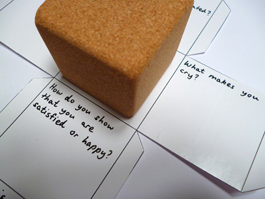
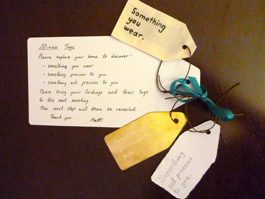
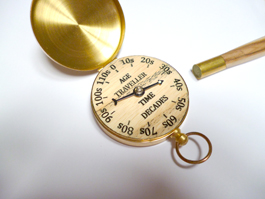
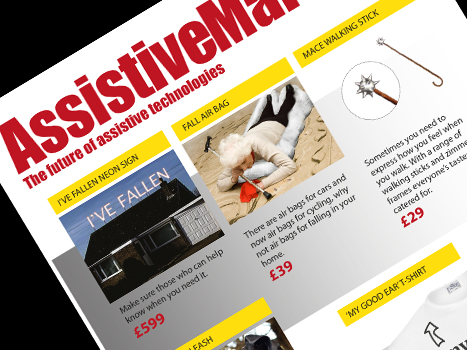
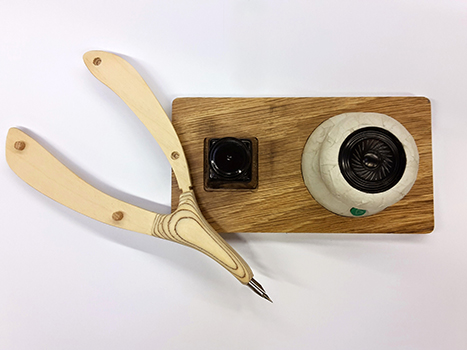
Perception, Empathy and Selfhood: An empathic design exploration into individual dementia through dialogical props
Keywords: design, dementia, dialogicality, empathy, personhood, perceptions
Your Dice
'Your Dice' is made up of a cube pattern cut out in card. In each square there is a question written on it, except one, which has the word 'blank'. This blank space is left that way to allow for adaption during discussion. There might be something that the participant wants to express or reiterate about him/herself that is not covered by the existing questions. From top to bottom, left to right, the hand-written questions are: 'How do you show that you are angry or frustrated?'; ‘What makes you laugh?'; ‘Blank…’; 'What makes you cry'; ‘How do you show that you are satisfied or happy?'; and, ‘What is one of your favourite phrases or sayings?'. They are hand-written in order to give an indication of a relaxed interaction that I am trying to encourage throughout the process. In addition, there is an oversized cork dice with blank faces for the participant to transfer his/her answers onto. The participant is asked if he/she has played games with dice in the past and I liken this situation to that one, stating that small bits of his/her personality are being transferred onto the surface of the dice and that the dice will be rolled to decide which aspect of them we will talk about. This first prop is one of the least theatrical of the objects so as to gently lead the participant into more imaginative acts throughout the first stage. It does, however, have the distinct physical interaction of rolling the dice that people could feel differently about. This prop is more about getting to know the participants but could also lead to key felt parts of their lives.
Magic Tags
The ‘Magic Tags’ prop consists of an over-sized card tag with hand-written instructions on it. This is for the same reason as stated above, to reinforce the informal feel of meetings. I did not want this piece to discourage handling. It asks the participants to collect three items from their home, with a second step to be clarified at the next meeting. It is written in a manner of an expedition using words like ‘explore’ and ‘discover’. They are asked for 'something you wear', ‘something precious to you’, and 'something not precious to you'. This is attached via a ribbon to three other more regular sized tags, each made from a different material. One tag is made from fabric and has ‘Something you wear.' written on it. Another is made from brass with 'Something precious to you.' engraved on it. The final one is made from card that has been ripped into its shape and with rough pencil writing, in a similar font to the engraving, says 'Something not precious to you.'. The title of ‘Magic Tags’, which is written on the instructions tag gives a hint towards the following step. At the next meeting, with the chosen items nearby, it is explained that each tag has the ability to give the corresponding object an ability/power/enhancement that the participant gets to choose. From the choice of objects as well as the choice of powers, the decisions can be discussed. From there, a conversation about the impact of those objects and their abilities on the participants’ lives can start. This could lead to things that each participant might want to change about their current situations.
Yolks of Life
‘Yolks of Life’ is the following prop to be put into action. It is actually three identical props, wooden eggs, halved and hinged, held shut by a rubber band or three. The participant is asked to collage onto the object with images ripped from magazines that represent connections to and things learnt from another person.
With a pile of magazines and three ‘Yolks of Life’ the participant is asked to imagine that each egg is a representation of a relationship and the images as pieces of that relationship. They are asked to think of the inside and outside of the object as showing the more personal, intimate and private aspects of the relationship and the more obvious readily apparent parts of their relationship respectively.
Age Traveller
The ‘Age Traveller’ takes the form of a brass-cased compass made to point to decades of life such as 40s, 50s and so on. A wooden wand with a brass tip is used to choose a particular decade. The face of the ‘Age Traveller’ has decades well beyond the age of the participants, implying that they have a future. “Today we will be travelling through time” will introduce the prop. Through similar language the activity is framed as if it actually happening, suspending our disbelief. Once a decade is chosen, we will discuss what it was like then, what we would need to take with us as travellers to that time, and how life has changed. As the participant will be doing most of the choosing, an indication of times that are preferred or just lent towards may appear. I would be sure to choose a decade in the not too distant future to see how the participant's perception of his/her life might be. This could be seen as a speculative prop in keeping with what makes a good speculative design, by Dunne and Raby. It clearly is not a commercial product but is well made and asks the participant or viewer to suspend his/her disbelief regarding an alternative reality that could have this object in it. It crosses over with Design Fiction but, according to Dunne and Raby, Design Fiction is more about creating convincing objects for our future.
Assistive Marvels pampletthe
This is a leaflet that could be seen as coming from a contemporary technology magazine with a humorous twist. This is in keeping with the concept that humans are innately playful beings. All the assistive technology products advertised are fictional and are presented as such to the participant. However, they reference real issues involving people with dementia and the elderly such as falls and forgetting how to get home. They range from a roof-mounted neon sign that alerts neighbours to a fall had by the resident to a way finding dog leash that leads the owner back to his or her home.
This prop also aligns with notions of Design Fiction, Speculative and Critical Design.
Good Speculative Design, from the perspective of Dunne and Raby, should have a touch of the absurd rather than being presented as real possibilities. Our perception of the absurd is largely personal but also strongly influenced by the society we live in. Consequently, the balancing of real/unreal, and humorous/not humorous becomes a difficult but not impossible task when multiple objects are presented. Therefore, some of the products portrayed on this leaflet could be seen as too real for their preferences for Speculative Design while others might seem too silly. I have kept this range to enable more possibilities to adapt within the interactions. I could make reference to more realistic or more playful versions of the products if I find that conversation comes more easily from one or the other.
Secret life of a Wishbone
This prop comprises of an oversized plywood wishbone with one partially cut prong and a dipping pen nib attached to the bottom end of the connecting part of the wishbone.
The participant is asked, via a standalone speaker and ink stand, to break the wishbone with someone, write a wish on the smaller piece, then push it onto the other prong to hide the wish. A discussion could then be had about the importance of keeping some things secret, such as wishes, wants and dreams. This could then be contrasted with how the participant has felt about such things prior to diagnosis. The physical act of breaking the wishbone is both performative as well as private for the participant. It invokes knowledge and feelings of breaking wishbones and making wishes, which is playful and imaginative while looking to the future. The wish is never shared with researcher given hope that the wish will come true, in keeping with tradition. The layers of interaction could not be achieved so easily through a regular interview method.
